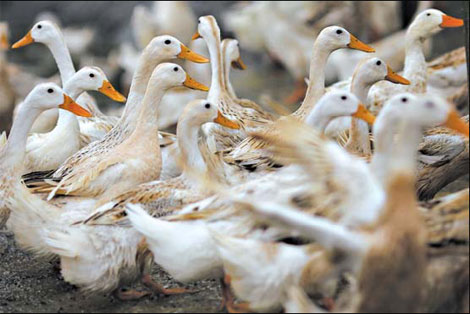Fears that amateurs might make deadly virus
Updated: 2012-04-15 07:36
By Carl Zimmer (The New York Times)
|
|||||||||||
|
Anxieties are rising that viruses like the bird flu could be made by do-it-yourself scientists, who can buy the lab equipment on eBay. [Na Son Nguyen / Associated Press] |
Just how easy is it to make a deadly virus?
The question has arisen recently, thanks to two controversial experiments that transformed the H5N1 bird flu virus into mutant forms that spread in mammals.
After months of intense worldwide debate, scientists brought together by the World Health Organization in February recommended publishing the results. And last month United States government biosecurity advisers said they support publishing the now-revised studies because they don't reveal details bioterrorists could use.
The journals Nature and Science say they plan to publish the works as soon as possible.
While terrorists and cults have long been a concern, some scientists also fear publication may allow curious amateurs to recreate the mutated virus - raising the risk of an accidental release.
Over the past decade, more amateur biologists have started to do genetic experiments of their own. The Web site DIYbio.org now has more than 2,000 members.
"I worry about the garage scientist, about the do-your-own scientist, about the person who just wants to try and see if they can do it," Michael T. Osterholm of the University of Minnesota said recently at a meeting of biosecurity experts in Washington, D.C.
Dr. Arturo Casadevall of the Albert Einstein College of Medicine in New York, who with Dr. Osterholm is a member of the board that initially recommended against publication, agreed, saying, "Humans are very inventive."
Do-it-yourself biologists say such fears are exaggerated.
"I am really sick and tired of folks waving this particular red flag," said Ellen D. Jorgensen, a molecular biologist who is president of Genspace, a "community biotechnology lab" in New York.
At the biosecurity meeting, Ron Fouchier, who led the Dutch team that created the mutated virus known as mutH5N1, described part of the experiment, which used well-established methods: Scientists introduced mutations into the H5N1 flu genes that they thought might help the bird flu infect mammals. They gave the viruses to ferrets, waited for them to get sick, then transferred viruses to other ferrets, ending up with a strain that could spread from one ferret to another in the air.
There are several ways trained virologists could make mutH5N1. They could take the publicly available genome sequence of H5N1 and rewrite it to include the new mutations, then simply copy the new sequence into an e-mail.
A DNA-synthesis company would then send back harmless segments of the flu's genes, pasted into the DNA of bacteria. The scientists could cut out the viral segments, paste them together and inject the reconstructed virus genes into cells. The cells would start making mutH5N1 viruses.
The synthesis companies look out for matches between requested DNA and the genomes of dangerous pathogens. But some experts dismiss such safeguards. "You could imagine a determined actor could cleverly disguise orders," Dr. Casadevall said.
Trained virologists, knowing the mutations acquired by mutH5N1, could simply alter ordinary H5N1 viruses at the same sites in its genes to match it.
Virologists might even figure out how to make mutH5N1 from the few details that have emerged. Reports say there were only five mutations in the Dutch viruses, and these were most likely at key sites involved in getting viruses into host cells. (Viruses have to infect host cells to reproduce; they cannot replicate on their own.)
Devices for duplicating pieces of DNA sell for a few hundred dollars on eBay.
D.I.Y. biologists sometimes laugh at the sinister powers people think they have. "People overestimate our technological abilities and underestimate our ethics," said Jason Bobe, a founder of DIYbio.org.
And amateurs lack the years of training it takes to grow viruses.
It is hard to predict how the evolution of biotechnology will affect the risk of homegrown pathogens. While it might be challenging to make one particular flu virus, like mutH5N1, it is not hard to try to breed new flu viruses.
"If you are a farmer somewhere in China, you could do it," said Steffen Mueller, a virologist at Stony Brook University in New York, by bringing some sick chickens in contact with ferrets.
Some experts say regardless of how a lethal virus might arise, the important thing is to be able to defeat it, to avoid a global catastrophe like the 1918 flu pandemic, which killed 50 million people.
"We need an urgent program for a generalized influenza vaccine," said Ron Atlas, a University of Louisville microbiologist. "We would take off the table another 1918-type event."
The New York Times
Today's Top News
Rescuers race against time for quake victims
Telecom workers restore links
Coal mine blast kills 18 in Jilin
Intl scholarship puts China on the map
More bird flu patients discharged
Gold loses sheen, but still a safe bet
US 'turns blind eye to human rights'
Telecom workers restore links
Hot Topics
Lunar probe , China growth forecasts, Emission rules get tougher, China seen through 'colored lens', International board,
Editor's Picks

|

|

|

|

|

|






